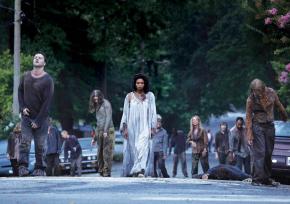Who are the real monsters?
Fans of the comic won't be disappointed by a new AMC series, says .
HAVING ENJOYED the first 48 issues of Robert Kirkman, Charlie Adlard, Tony Moore and Cliff Rathburn's popular comic series The Walking Dead, which inspired a new zombie series on AMC, I watched with great curiosity to see how it would handle an early scene in which a young Black boy hits a sheriff's deputy over the head with a shovel.
The boy, Duane, mistakes a rough-looking Rick Grimes, who had wandered from his hospital bed where he laid comatose for weeks, for a zombie.
As it turned out, writer and producer Frank Darabont, who also adapted Stephen King's The Shawshank Redemption and The Green Mile for film, wasn't at all cautious about a police head-thumping. In fact, in another display of audacity, the first scene of the series is a sequence in which our deputy shoots a teddy bear-clutching, bunny slipper-wearing little blonde girl in the head.
No mistake there--she was a zombie.
Zombies are a hot cultural item, and the cable network AMC is seeking to expand on its recent Mad Men success by adapting the New York Times best-selling comic book series for television. The Halloween premiere drew more than 5.3 million viewers and seems to have allayed comic series fans' concerns that the basic cable format might be too restrictive for the blood-and-flesh-eating gore-fest typical of the zombie genre.

Whether intentional or not, zombie films have long been viewed as metaphors for a variety of social anxieties and conflicts, from racist fears (White Zombie) and racism (Night of the Living Dead), to rampant consumerism (Dawn of the Dead) and class conflict (Land of the Dead).
While Darabont's adaptation fits neatly into the established zombie genre, it, like the original comic, is a strong character-driven story, with the zombie plague serving as a menacing backdrop to a Hurricane Katrina-like social catastrophe set in present-day Atlanta.
In fact, the Katrina analogies jump out at the viewer from the earliest scenes, with spray-painted "Dead Inside" warnings evoking the terrible notifications spray-painted on New Orleans buildings. Also, the widespread signs of the total collapse of government authority echoes the Katrina-like sense that survivors are completely on their own.
THE CHOICE of slow-moving zombies in The Walking Dead--a return to classic George Romero films Night of the Living Dead and Dawn of the Dead--evokes natural or even ecological disaster. You can walk past these zombies fast enough, but as your presence disturbs the landscape, the zombies are aroused and slowly fall behind you. The farther you travel, the more zombies you awaken until finally, as you arrive at your destination, you find hundreds of zombies lumbering hot on your heals.
These zombies don't scream or run as in Danny Boyle's 28 Days Later. Instead, they're slow, moaning, relentless forces of nature--unstoppable in their drive and overwhelming in their numbers, like waves overtopping a levy.
Interestingly, in both the film and the comic, there are a series of meditations on the tragedy of the zombies themselves. A zombie can be slowed by a chain-link fence or a locked door, but this simply provides opportunities for sad and oddly intimate encounters with animated, rotting husks of the departed (and the inevitable mistake of getting too close). Are the zombies suffering? Is putting down the bike-girl zombie a form of euthanasia?
Back to the story--Rick's bumpy encounter with Duane and his father Morgan turns out to be a good thing. Morgan takes in Rick and catches him up on some of the things he's missed while he's been asleep--such as the end of the world.
Rick learns that early survivors were told to go to big cities for shelter (big mistake...think Louisiana Superdome) and decides to follow along to Atlanta in the hopes of finding his wife and son. After finding a horse, Rick gallops into Atlanta, only to find it has become a zombie central.
Without giving out spoilers or pre-judging what the TV adaptation will bring of its own, what in the end makes the series both fascinating and disturbing isn't the question of whether humans survive the zombie-plague, but how?
In one early scene, Rick's best friend and partner Shane is venting sexist idiocy about how women can't turn off the lights to save electricity and are to blame for global warming. If the zombie plague might be seen as metaphor for environmental catastrophe, then Shane's mean-spirited dialogue gives a small hint at who, in Darabont's view, the real monsters are.
However, it would be a mistake to call the series preachy or even political. Instead, it provides a broad range of people's capacity for both solidarity and barbarism. The Walking Dead tells of efforts to build community and also shows how the barriers of racism, fear, selfishness and violence tear down and destroy that community. Individual characters can be both inspiringly heroic and dishearteningly nasty.
And for zombie fans, it's good gory fun.


